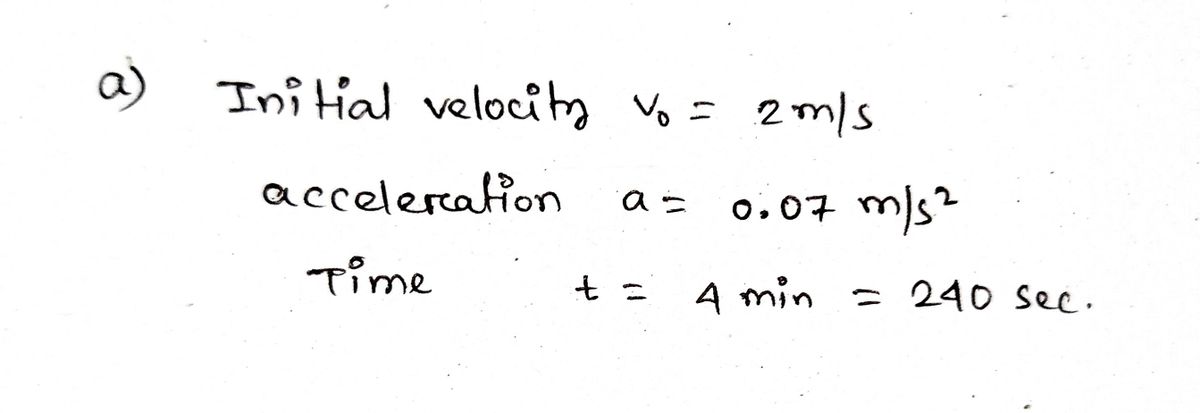Freight trains can produce only relatively small accelerations and decelerations. Leg 1 What is the final velocity and position of a freight train that accelerates at a rate of 0.0700 m/s² for 4.00 minutes, starting with an initial velocity of 2.00 m/s? (a) • Using the notation Ax=x-xo for displacement, x for final position, xo for initial position, v for final velocity, v for initial velocity, a for acceleration, and t for time, determine what quantities are known and what quantities are unknown. • Enter the values of some known quantities below. • Make sure you account for the signs of the vectors using the coordinate system in Part 1. Enter to 3 significant figures. Enter with correct signs. Vo = m/s m/s² a = t= S (b) is the motion of the freight train one with constant velocity or constant acceleration? This will help you choose the correct equations of motion. (c) Choose an appropriate equation of motion from List 1 to calculate the final velocity of the train after 4.00 minutes. List 1 Ax= vt Ax= (v₁ + v) ₁ t 2 v=v₁ + at ✓= √²+2a4x
Freight trains can produce only relatively small accelerations and decelerations. Leg 1 What is the final velocity and position of a freight train that accelerates at a rate of 0.0700 m/s² for 4.00 minutes, starting with an initial velocity of 2.00 m/s? (a) • Using the notation Ax=x-xo for displacement, x for final position, xo for initial position, v for final velocity, v for initial velocity, a for acceleration, and t for time, determine what quantities are known and what quantities are unknown. • Enter the values of some known quantities below. • Make sure you account for the signs of the vectors using the coordinate system in Part 1. Enter to 3 significant figures. Enter with correct signs. Vo = m/s m/s² a = t= S (b) is the motion of the freight train one with constant velocity or constant acceleration? This will help you choose the correct equations of motion. (c) Choose an appropriate equation of motion from List 1 to calculate the final velocity of the train after 4.00 minutes. List 1 Ax= vt Ax= (v₁ + v) ₁ t 2 v=v₁ + at ✓= √²+2a4x
College Physics
11th Edition
ISBN:9781305952300
Author:Raymond A. Serway, Chris Vuille
Publisher:Raymond A. Serway, Chris Vuille
Chapter1: Units, Trigonometry. And Vectors
Section: Chapter Questions
Problem 1CQ: Estimate the order of magnitude of the length, in meters, of each of the following; (a) a mouse, (b)...
Related questions
Question

Transcribed Image Text:(g) Time taken for the train to come to a stop.
Enter to 3 significant figures
✔S
Choose an appropriate equation of motion from List 1 to calculate how far the train will travel
before stopping.
(h) Displacement of the train before stopping (Leg 2 only).
Enter to 3 significant figures
Δx=
✔m

Transcribed Image Text:Freight trains can produce only relatively small accelerations and decelerations.
Leg 1
What is the final velocity and position of a freight train that accelerates at a rate of 0.0700 m/s²
for 4.00 minutes, starting with an initial velocity of 2.00 m/s?
(a)
• Using the notation Ax= x-xo for displacement, x for final position, xo for initial position,
v for final velocity, vo for initial velocity, a for acceleration, and t for time, determine what
quantities are known and what quantities are unknown.
• Enter the values of some known quantities below.
• Make sure you account for the signs of the vectors using the coordinate system in Part 1.
Enter to 3 significant figures. Enter with correct signs.
Vo =
a =
t =
(b) Is the motion of the freight train one with constant velocity or constant acceleration? This will help
you choose the correct equations of motion.
Ax= vt
(c) Choose an appropriate equation of motion from List 1 to
calculate the final velocity of the train after 4.00 minutes.
List 1
Δx=
(vo + v)
2
✔m/s
m/s²
t
S
V = V₁ + at
✓²= √²+2a4x
Expert Solution
Step 1: Determine the given information

Step by step
Solved in 4 steps with 3 images

Knowledge Booster
Learn more about
Need a deep-dive on the concept behind this application? Look no further. Learn more about this topic, physics and related others by exploring similar questions and additional content below.Recommended textbooks for you

College Physics
Physics
ISBN:
9781305952300
Author:
Raymond A. Serway, Chris Vuille
Publisher:
Cengage Learning

University Physics (14th Edition)
Physics
ISBN:
9780133969290
Author:
Hugh D. Young, Roger A. Freedman
Publisher:
PEARSON

Introduction To Quantum Mechanics
Physics
ISBN:
9781107189638
Author:
Griffiths, David J., Schroeter, Darrell F.
Publisher:
Cambridge University Press

College Physics
Physics
ISBN:
9781305952300
Author:
Raymond A. Serway, Chris Vuille
Publisher:
Cengage Learning

University Physics (14th Edition)
Physics
ISBN:
9780133969290
Author:
Hugh D. Young, Roger A. Freedman
Publisher:
PEARSON

Introduction To Quantum Mechanics
Physics
ISBN:
9781107189638
Author:
Griffiths, David J., Schroeter, Darrell F.
Publisher:
Cambridge University Press

Physics for Scientists and Engineers
Physics
ISBN:
9781337553278
Author:
Raymond A. Serway, John W. Jewett
Publisher:
Cengage Learning

Lecture- Tutorials for Introductory Astronomy
Physics
ISBN:
9780321820464
Author:
Edward E. Prather, Tim P. Slater, Jeff P. Adams, Gina Brissenden
Publisher:
Addison-Wesley

College Physics: A Strategic Approach (4th Editio…
Physics
ISBN:
9780134609034
Author:
Randall D. Knight (Professor Emeritus), Brian Jones, Stuart Field
Publisher:
PEARSON